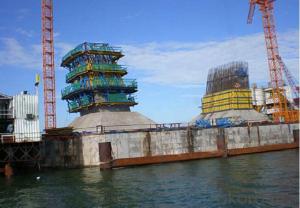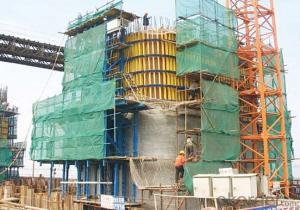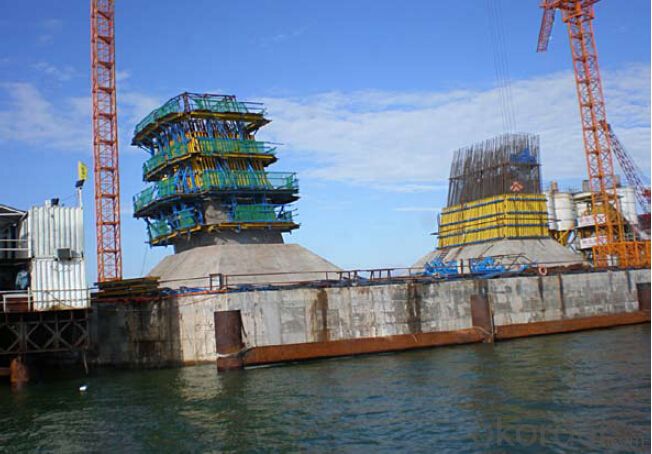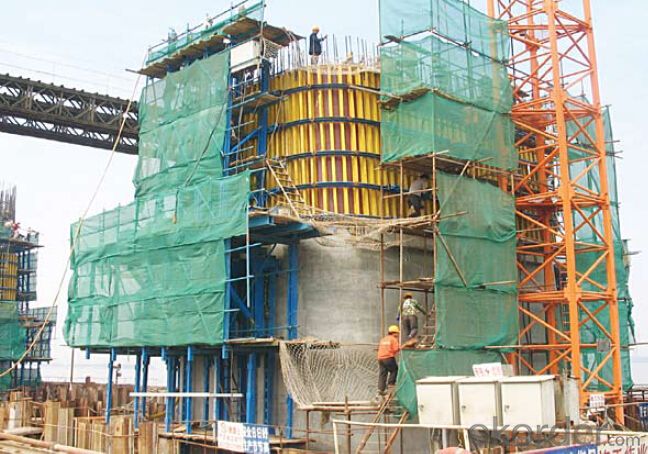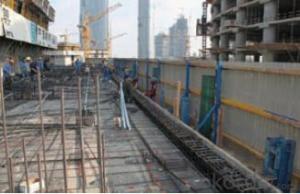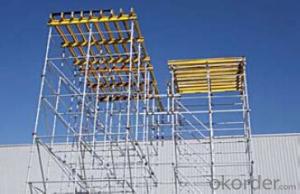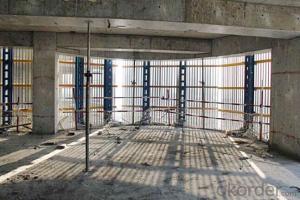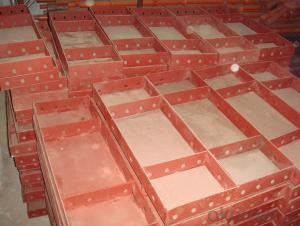Auto climbing bracket ACB-100 for formwork and scaffolding system
- Loading Port:
- Tianjin
- Payment Terms:
- TT OR LC
- Min Order Qty:
- 50 m²
- Supply Capability:
- 1000 m²/month
OKorder Service Pledge
OKorder Financial Service
You Might Also Like
Auto-climbing Bracket ACB100 & ACB50
The power of the auto-climbing formwork is the hydraulic system, which includes the oil cylinder
and two commutators. The commutators can control the climbing of climbing rail and the bracket.
The steel rail and the bracket can inter-climbing, so the whole system will climb up steadily.
Cranes are not needed during the construction. It’s easy to operate, highly efficient and safe. It’s
the best choice for the construction of high buildings and bridges.
There are mainly two types of standard auto-climbing brackets, ACB-50 and ACB-100, the figure
means the push power of cylinder with unit of KN.
Characteristics:
◆ Perfect load bearing anchor system
Anchor system is the most important supporting part. The system is made of five parts shown
below. Thereinto, tensile bolt, V-climbing cone and washer can be taken out for reusing after the
concrete pouring finished.There are two kinds of anchor systems,A & B. A is matched with single
anchor shoe and B is matched with double anchor shoe.
◆ Crane-independent
Crane-independent forming, striking and climbing speeds up the work procedures on the
construction site and also makes them independent of each other. This means the planned
sequences can be maintained along with guaranteeing high productivity levels. The crane can
therefore be used for other tasks.
Hydraulic system is mainly made of two commutators,
oil cylinder and power distribution system.The
commutators can control the climbing of climbing rail
and bracket.
◆ High bearing capacity and safe
The stable working platforms are able to carry large loads, e.g. the storage of reinforcing steel
for the next climbing section. Generously-sized working platforms, the well thought-out design for
handling very high wind loads and the patented control function of the climbing mechanism are
some of the special details contained within the comprehensive safety concept.
◆ Platforms adjusted to suit the angle of inclination
The horizontal working areas thus created provide safe and comfortable conditions for
reinforcement work, shuttering and striking, concreting and finishing.
◆ The ACB formwork system can climb not only vertically but also slantways, the largest angle is
18 degrees.
◆ The system can climb up wholly or separately. The climbing process is steady, synchronous
and safe.
◆ The bracket will not fall to the ground until the construction is finished, the field will be saved
and the impacting breakage will be reduced (especially the panel).
◆ The system will furnish omnidirectional platform, the construction organizations don’t need to
set up additional operation platform.
◆ The error of structure construction is small and easy to correct.
◆ The climbing speed is fast, the construction course will be quickened.
◆ The formwork can climb itself and cleaning work can be done in the same situs , the used times
of tower crane will be greatly reduced.
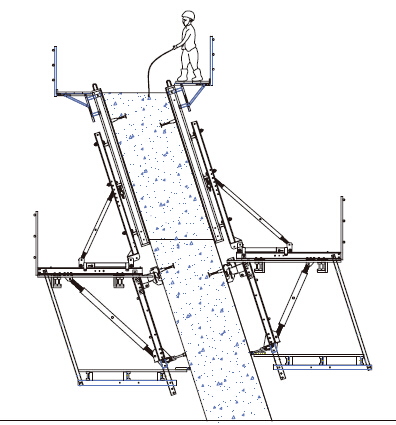
- Q: Can steel formwork be used for both single-sided and double-sided forming?
- Steel formwork is capable of being utilized for both single-sided and double-sided forming. Renowned for its strength and durability, steel formwork is well-suited for various construction applications. In the case of single-sided forming, the steel panels are firmly secured against a solid surface or pre-existing structure, acting as a barrier to retain the concrete until it solidifies. Conversely, for double-sided forming, steel formwork panels are employed on both sides of the concrete pour, creating a mold that holds the concrete in place and provides a sleek finish on both sides of the structure. The versatility of steel formwork permits its utilization in a wide array of construction projects, encompassing walls, columns, beams, slabs, and more.
- Q: How long does steel formwork last?
- Various factors, including the quality of the steel used, the frequency and type of usage, and the maintenance practices employed, can affect the lifespan of steel formwork. Typically, steel formwork is renowned for its durability and longevity, and with proper maintenance, it can endure for numerous years or even decades. When steel formwork is consistently maintained and handled correctly, it can endure multiple uses and continue to function effectively. However, it is important to acknowledge that over time, steel formwork may experience wear and tear due to constant exposure to concrete, which can result in surface corrosion or deterioration. To address this, protective coatings can be applied or the formwork can be cleaned after each use. Moreover, external factors like environmental conditions and the type of concrete used can also impact the lifespan of steel formwork. Exposure to harsh weather conditions or chemicals can expedite the corrosion process, potentially reducing the formwork's lifespan. To ensure the durability of steel formwork, it is crucial to invest in high-quality steel with proper anti-corrosion properties, conduct regular inspections, and perform necessary maintenance and repairs as required. By adhering to these practices, steel formwork can endure for a significant period, making it a cost-effective and dependable choice for construction projects.
- Q: Can steel formwork be used for architectural concrete slabs?
- Architectural concrete slabs can indeed utilize steel formwork. When compared to other formwork materials, steel formwork boasts numerous advantages in terms of its strength, durability, and versatility. By providing a rigid structure, it can effectively withstand the pressure exerted by fresh concrete, thereby guaranteeing accurate and precise placement of the slabs. Moreover, steel formwork can be conveniently reused multiple times, rendering it both cost-effective and environmentally friendly. Its smooth surface further contributes to the attainment of high-quality finishes for architectural concrete slabs. Nevertheless, it remains crucial to ensure proper insulation and the use of release agents to prevent heat transfer and potential concrete adherence issues caused by the steel. All in all, steel formwork proves to be a dependable and efficient choice for the creation of architectural concrete slabs.
- Q: How does steel formwork handle surface imperfections in concrete?
- Steel formwork is a rigid and durable material that is able to handle surface imperfections in concrete effectively. Its strength and stability allow it to support the weight of wet concrete, preventing any deformation or distortion caused by uneven surfaces. Additionally, steel formwork provides a smooth and uniform surface, minimizing any irregularities or blemishes that may occur during the pouring and curing process of concrete. Overall, steel formwork offers excellent resistance to surface imperfections, resulting in high-quality and aesthetically pleasing concrete finishes.
- Q: Can steel formwork be used for both interior and exterior concrete placement?
- Yes, steel formwork can be used for both interior and exterior concrete placement. Steel formwork is known for its durability and strength, making it suitable for various construction projects. It provides a stable and rigid structure that can withstand the pressure and weight of the concrete during the pouring and setting process. Moreover, steel formwork can be easily assembled and disassembled, allowing for efficient use in both interior and exterior applications. Whether it is for building walls, columns, slabs, or other concrete elements, steel formwork offers a versatile solution that can be used in different environments and conditions.
- Q: Can steel formwork be used for both monolithic and composite structures?
- Indeed, steel formwork is applicable to both monolithic and composite structures. This option is known for its versatility and durability, enabling it to endure the pressures and forces associated with these two types of constructions. For monolithic structures, wherein concrete is poured continuously, steel formwork plays a crucial role in providing the necessary support and containment for the fresh concrete. Its easy assembly and disassembly facilitate the efficient construction of monolithic structures like walls, slabs, and columns. The robustness and rigidity of steel formwork ensure its ability to withstand the weight and pressure of the concrete during pouring and curing. On the other hand, composite structures involve combining various materials, such as steel and concrete, to create a more efficient and sturdy structure. In this case, steel formwork can be employed to provide support for the concrete component while accommodating other materials like steel beams or columns. The adaptability of steel formwork allows for the integration of different materials, making it suitable for constructing composite structures like bridges, high-rise buildings, and industrial facilities. In both scenarios, steel formwork offers several advantages compared to other formwork materials. Its strength and durability guarantee the ability to withstand the pressures and forces exerted during construction, thereby resulting in a safer and more efficient building process. Moreover, steel formwork can be reused multiple times, reducing construction costs and minimizing waste. All in all, steel formwork is a reliable and versatile choice for both monolithic and composite structures.
- Q: Can steel formwork be used for road construction?
- Indeed, road construction can involve the utilization of steel formwork. This particular method is widely favored in road construction endeavors owing to its exceptional resilience, robustness, and adaptability. Given its ability to endure substantial loads and pressure, it is highly suitable for the creation of durable and enduring road surfaces. The assembly and disassembly of steel formwork is a straightforward process, thereby facilitating efficient construction procedures and expediting project completion. Moreover, this formwork can be reused on numerous occasions, rendering it an economically sensible choice for road construction projects.
- Q: What types of structures can steel formwork be used for?
- A wide variety of structures, such as residential buildings, commercial buildings, industrial buildings, bridges, tunnels, dams, and even high-rise buildings, can benefit from the use of steel formwork. Its strength and versatility make it a suitable choice for different concrete construction projects. To ensure accurate and precise concrete pouring, steel formwork systems can be tailored and designed to meet the specific needs of various structures. Furthermore, steel formwork is long-lasting and reliable, capable of handling the pressure exerted by wet concrete. This durability makes it an ideal option for large-scale projects that require trustworthy and enduring formwork systems.
- Q: How does steel formwork differ from other types of formwork?
- Steel formwork differs from other types of formwork in several ways. Firstly, steel formwork is known for its durability and longevity. Unlike wooden or plastic formwork, which may require frequent replacements due to wear and tear, steel formwork can withstand heavy usage and can be reused multiple times. This makes it a cost-effective option in the long run, as it eliminates the need for constant formwork replacements. Additionally, steel formwork offers a higher level of precision and accuracy in construction. The rigid structure of steel formwork ensures that the concrete is poured and cured in the desired shape and dimensions. This is particularly important in projects that require high-quality finishes or complex architectural designs. Moreover, steel formwork provides excellent structural support. It can withstand the pressure exerted by wet concrete without deforming or collapsing, ensuring the stability and safety of the construction process. This is especially crucial in large-scale projects or in situations where high concrete volumes are involved. Furthermore, steel formwork is versatile and can be easily customized to meet specific project requirements. It can be easily assembled and disassembled, allowing for quick and efficient construction processes. Steel formwork can also be adjusted to accommodate different shapes and sizes, making it suitable for a wide range of construction projects. Lastly, steel formwork is highly resistant to weather conditions and environmental factors. Unlike wooden formwork, which may warp or deteriorate when exposed to moisture, steel formwork remains stable and unaffected by changes in temperature or humidity. This makes it suitable for both indoor and outdoor construction projects. In conclusion, steel formwork stands out from other types of formwork due to its durability, precision, structural support, versatility, and resilience to environmental factors. It offers numerous advantages that make it a preferred choice for many construction projects.
- Q: How does steel formwork affect the overall durability of the structure?
- Steel formwork can have a significant impact on the overall durability of a structure. Steel is known for its strength and durability, making it an ideal material for formwork. One of the key ways in which steel formwork affects the durability of a structure is through its ability to withstand the forces and pressures exerted during the construction process. Steel formwork provides excellent support and stability to the concrete during pouring and curing, ensuring that it maintains its shape and strength. This helps to prevent any deformation or cracking that could compromise the overall durability of the structure. Additionally, steel formwork is highly resistant to wear and tear, which is crucial for projects that involve multiple concrete pours. Unlike other types of formwork such as timber, steel formwork does not warp, shrink, or expand due to moisture or temperature changes. This allows for multiple uses and reuses, reducing the need for frequent replacements and ultimately increasing the lifespan of the structure. Furthermore, steel formwork offers superior protection against environmental factors such as corrosion and fire. Steel is inherently resistant to rust and decay, which can significantly extend the lifespan of the formwork and consequently the structure itself. Moreover, steel formwork provides higher fire resistance compared to other materials, reducing the risk of structural damage and enhancing the overall durability of the building. In summary, steel formwork positively affects the overall durability of a structure by providing excellent support, stability, and protection against various forces and environmental factors. Its strength, resistance to wear and tear, and superior properties make it a reliable choice for construction projects, ensuring the longevity and durability of the structure.
Send your message to us
Auto climbing bracket ACB-100 for formwork and scaffolding system
- Loading Port:
- Tianjin
- Payment Terms:
- TT OR LC
- Min Order Qty:
- 50 m²
- Supply Capability:
- 1000 m²/month
OKorder Service Pledge
OKorder Financial Service
Similar products
Hot products
Hot Searches
